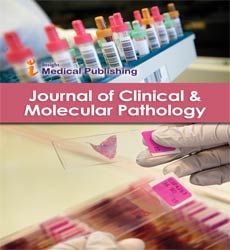ISSN : 2634-7806
Journal of Clinical and Molecular Pathology : Open Access
A Current View on Clinical Pathology
Liang Cao*
Discipline of Pharmacology, School of Pharmacy, University of the Western Cape, Bellville 7535, South Africa
- *Corresponding Author:
- Liang Cao
Department of Microbiology-Immunology
Feinberg School of Medicine, Northwestern University
Chicago, IL, USA
Tel: 312-477-1368
E-mail: Liang.cao@northwestern.edu
Received date: September 4, 2017; Accepted date: September 4, 2017; Published date: September 5, 2017
Citation: Cao L (2017) A Current View on Clinical Pathology. J Clin Mol Pathol 1:14.
Copyright: © 2017 Cao L. This is an open-access article distributed under the terms of the Creative Commons Attribution License, which permits unrestricted use, distribution, and reproduction in any medium, provided the original author and source are credited.
Editorial
Pathology is a medical specialty generally defined as the characterization of disease, ranging from the macroscopic level to the molecular level, through the use of modern tools of biochemistry, microbiology, and immunology. However, the context and the understanding of pathology are constantly improving, with new technologies and newly identified target molecules that can be applied for the medical care.
Clinical pathology is very important for confirming the pathogenesis of chronic or acute infectious disease, tissue injury, metabolic syndrome and cancer; it is also critical for establishing new techniques for the identification and surveillance of emerging infectious diseases. Moreover, the use of pathology for long-term follow-up care on metabolic syndrome and cancer progression will greatly improve patient’s health outcomes. New findings in clinical pathology in the lab have the potential to be translated into clinical treatment and diagnosis, with the longterm goal of improving patient health. New state of the art improvements in the pathology field have led to techniques to accurately and systemically analyze the changes in molecular regulation networks and sequence metabolic profiles even at the single cell-based level. The instrumental technique, RNAseq and proteomics analysis have been used to explore epigenetic view targeting histone-methylation, RNA modification, and protein homeostasis as well as the composition of the exosome. Advances in pathology techniques and in burgeoning research areas add to broad knowledge in the field and influencing clinical practice as well as the clinical pathologist. High standard of the interdisciplinary knowledge background will be required to be a current clinical pathologist in his field who will play the role as “information analysis expert” with the aid of the computerization to collect, to analyze, to assemble and to make a conclusion.
Our journal: Journal of Clinical & Molecular Pathology is a multidisciplinary peer-reviewed journal that publishes manuscripts on clinical pathology, anatomic pathology, as well as the translational study of molecular biology, biochemistry, genetics proteomics, chemistry, hematology and microbiology for the diagnosis and analysis of disease. Our journal widely publishes on research articles, review articles, case reports, short communication, commentary, letters to editor and editorials. These publications showcase current concepts and techniques, and developments in diagnostic methods, especially those that measure molecular changes in organs and tissue cells. Compared to others, our journal offers a convenient submission system, fast peer-review time, and high-standard online publication with freely accessible browse. Clinical pathology requires the collaboration with academic researchers, medical technician, hospital administrators and related-physician. Therefore, we serve the need of the medical practitioners, researchers, lab professional, students and postdocs, academicians and industry related in the clinical pathology.
Clinical pathology will keep evolving at a rapid speed in the areas of molecular diagnostics and administration and prediction of pathogenesis as well as the personalized medicine. Pathology Research on emerging infectious diseases and developing fields should not only offer new insights and novel concepts, but also new challenges, ideas, and opportunities, which could impact the field of translational medicine.
Open Access Journals
- Aquaculture & Veterinary Science
- Chemistry & Chemical Sciences
- Clinical Sciences
- Engineering
- General Science
- Genetics & Molecular Biology
- Health Care & Nursing
- Immunology & Microbiology
- Materials Science
- Mathematics & Physics
- Medical Sciences
- Neurology & Psychiatry
- Oncology & Cancer Science
- Pharmaceutical Sciences
